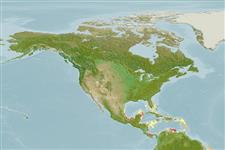Elasmobranquios (tiburones y rayas) (sharks and rays) >
Squatiniformes (Angel sharks) >
Squatinidae (Angel sharks)
Etymology: Squatina: Latin for skate, which angel sharks superficially resemble, presumably tautonymous with Squalus squatina Linnaeus 1758 (no species mentioned) (See ETYFish); mexicana: Named for its type locality, Mexico.
Issue
Synonym of Squatina dumeril according to (Weigmann, 2016, Ref. 106604).
Environment: milieu / climate zone / depth range / distribution range
Ecología
marino demersal; rango de profundidad 71 - 180 m (Ref. 74686). Tropical
Western Atlantic: Gulf of Mexico.
Tamaño / Peso / Age
Maturity: Lm ? range ? - ? cm
Max length : 88.0 cm TL macho / no sexado; (Ref. 74686)
Short description
Claves de identificación | Morfología | Morfometría
This species has no thorns or enlarged denticles on the mean dorsal line. The dermal skin denticles has 3 keels extended posteriorly, its base about 4 times its length. The dorsal fins are similar in size, shape and area, their base about 1.75 times their height. Nasal lobes are simple, the anterior thin and longer; the medium lobe quadrangular and almost lacking lobes Body color gray, no ocelli, but with 2 very evident black spots on the anterior edge of pectoral fins; the rest of body is black with small scattered dark spots located irregularly. Both sides of the upper jaw has 10 triangular, erect, and non edge-serrated teeth, arranged in 2 functional series; lower jaw with 9-10 smooth triangular teeth; 5 frontal teeth are straight, the rest are slightly oblique and arranged in 2 functional series (Ref. 74686).
Life cycle and mating behavior
Madurez | Reproducción | Puesta | Huevos | Fecundidad | Larva
Castro-Aguirre, J.L., H.S. Espinosa Pérez and L. Huidobro Campos, 2006. Dos nuevas especies del género Squatina (Chondrichthyes: Squatinidae) del Golfo de México. Rev. Biol. Trop. (Int. J. Trop. Biol.) [2006] 54 (3):1031-1040. (Ref. 74686)
IUCN Red List Status (Ref. 130435: Version 2024-1)
Threat to humans
Harmless
Human uses
Herramientas
Special reports
Download XML
Fuentes de Internet
Estimates based on models
Preferred temperature (Ref.
123201): 19.7 - 26, mean 21.8 °C (based on 13 cells).
Phylogenetic diversity index (Ref.
82804): PD
50 = 0.5000 [Uniqueness, from 0.5 = low to 2.0 = high].
Bayesian length-weight: a=0.00676 (0.00295 - 0.01551), b=3.07 (2.88 - 3.26), in cm total length, based on LWR estimates for this Genus-body shape (Ref.
93245).
Nivel trófico (Ref.
69278): 4.0 ±0.6 se; based on size and trophs of closest relatives
Resiliencia (Ref.
120179): Bajo, población duplicada en un tiempo mínimo de 4.5-14 años (Preliminary low fecundity).
Fishing Vulnerability (Ref.
59153): High vulnerability (55 of 100).
